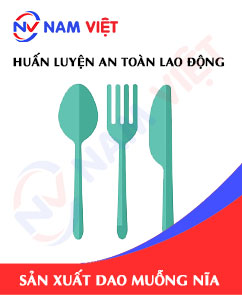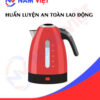Occupational Safety Training in Cutlery (Knives, Spoons, and Forks) Manufacturing
99,000 ₫
Note: The above price is calculated for one person, and the price may fluctuate depending on the number of trainees participating in the course and market movements. For more accurate pricing support, please refer to the quotation table or contact our consulting staff directly.
Occupational safety is an important issue in cutlery manufacturing factories and needs to be addressed promptly to ensure the health and safety of workers, while enhancing the reputation of businesses. The Occupational safety training course is one of the effective solutions to raise awareness of accident prevention for workers participating in cutlery manufacturing.
Table of Contents
Toggle1. Overview of Cutlery (Knife, Spoon, Fork)
a. What is Cutlery?
Cutlery refers to a set of utensils used in the kitchen for cutting, slicing, and assisting in eating food. This set includes knives, spoons, and forks, typically made from materials such as stainless steel, ceramic, wood, or plastic. Cutlery can vary in size, shape, and function depending on the intended use and the characteristics of different types of food.

b. Types of Machinery for Cutlery Production
The types of machinery used in cutlery production include:
- Steel Sheet Cutting Machine: This machine is used to cut steel sheets into various sizes and shapes to create knife blades, knife bodies, and handles.
- Knife Grinding Machine: This machine is used to sharpen knife blades to achieve the necessary sharpness.
- Heat Press Machine: This machine is used to press the components of the knife into a complete product.
- Spray Dyeing Machine: This machine is used to spray color on cutlery to achieve the desired design and appearance.
- Packaging Machine: This machine is used to pack the finished product, ready for shipping and sale.

c. Cutlery Manufacturing Companies in Vietnam
There are many companies producing cutlery in Vietnam, including:
- Hoa Phat Trading and Manufacturing Company Limited: One of the largest companies in Vietnam specializing in stainless steel products such as cutlery, chopsticks, spoons, pots, pans, etc.
- Tan Hung Phat Production and Trading Company Limited: This company specializes in manufacturing cutlery and other kitchen products. It offers a variety of designs and types to meet customer needs.
- Son Tung Hand Tools One Member Limited Company: Located in Hanoi, this company specializes in producing hand tools, including cutlery, scissors, etc.
- Quang Minh Production and Trading Company Limited: Located in Ho Chi Minh City, this company produces cutlery, chopsticks, plates, bowls, glasses, and also provides stainless steel and other kitchen products.

d. Specific Jobs in Cutlery Manufacturing Plants
Group 1
- Executive Director, Deputy Executive Director, Department Heads in the cutlery manufacturing plant.
Group 2
- Safety Officers: manage safety in the plant, design safety procedures, monitor and enforce employees’ compliance with safe working procedures.
Group 3
- Blade Manufacturing: This is the main stage in cutlery production. Knife blades are made from stainless steel or carbon steel, then polished and sharpened to create a precise cutting edge.
- Handle Manufacturing: Handles for knives, spoons, and forks are usually made of plastic or wood. They are designed for comfortable and non-slip grip during use.
- Assembly: Knife blades and handles are assembled to form a complete product. Other components such as screws and rivets are used to secure the parts together.
- Quality Control: After production, cutlery is inspected to ensure compliance with safety and quality standards.
- Packing and Shipping: Finally, cutlery is packed and prepared for distribution to retail stores or distributors.
Group 4
- Office work, service, sales, marketing.
- Production management, quality management, human resource management, materials management, financial and accounting management.
- Research and development of new products, designing packaging and product samples.

2. Overview of Occupational Safety Training for Cutlery Production
In this article, we focus on Group 3 because Group 3 is directly involved in production and faces the highest occupational safety risks. For other groups, refer here.
a. What is Group 3 Occupational Safety Training?
- Group 3 Occupational Safety Training consists of sessions that provide workers with awareness and skills to prevent workplace accidents.
- The training course helps workers identify hazards and avoid risks, reducing the likelihood of accidents while working.
REGISTER FOR OCCUPATIONAL SAFETY TRAINING SERVICE
b. Training Duration
Initial Safety Training Duration
- The total training duration is at least 24 hours, including assessment time.
- 8 hours of theory on safety and labor hygiene policies and legislation
- 8 hours of theory on basic occupational safety and hygiene knowledge
- 4 hours of theory on specialized training content
- 2 hours of practice on specialized training content
- 2 hours of theory assessment at the end of the training course
The safety training center will distribute the course over multiple sessions depending on worker schedules. Typically, there are 6 sessions conducted over 3 days, assuming the company arranges continuous training time.
Periodic Safety Training Duration
- Before the occupational safety card expires, workers who want renewal must attend periodic occupational safety training with a duration of at least 50% of the initial training time.
Explanation: the total duration of periodic occupational safety training is at least 12 hours, including assessment time. After completing the periodic training and passing the test, workers will be reissued or extended their occupational safety card.
c. Training Content
| No. | TRAINING CONTENT | TRAINING DURATION (HOURS) | |||
| Total | Including | ||||
| Theory | Practice | Assessment | |||
| I | Policies and Legislation on Occupational Safety and Hygiene | 8 | 8 | 0 | 0 |
| 1 | Overview of occupational safety and hygiene legal documents. | 6 | 6 | ||
| 2 | Standards and technical regulations on occupational safety and hygiene. | 1 | 1 | ||
| 3 | Specific regulations of state management agencies on occupational safety and hygiene when constructing, expanding, or renovating production facilities, and handling, storing, and inspecting machinery, equipment, materials, and substances requiring strict safety and hygiene standards. | 1 | 1 | ||
| II | Basic Knowledge of Occupational Safety and Hygiene | 8 | 8 | 0 | 0 |
| 1 | Basic knowledge of hazards and harmful factors at the workplace. | 4 | 4 | ||
| 2 | Methods to improve working conditions. | 1 | 1 | ||
| 3 | Safety culture in production and business. | 1 | 1 | ||
| 4 | Rights and obligations of employers and employees; policies on occupational safety and hygiene; roles and duties of safety network personnel. | 1 | 1 | ||
| 5 | Occupational safety regulations, signage, safety instructions, usage of safety equipment and personal protective equipment; skills in first aid, accident prevention, and occupational disease prevention. | 1 | 1 | ||
| III | Specialized Training Content | 6 | 4 | 2 | 0 |
| Comprehensive knowledge of machines, equipment, substances generating hazardous factors; analysis, evaluation, and management of occupational safety risks; safe working procedures with machines, equipment, and substances requiring strict safety and hygiene standards. | 6 | 4 | 2 | ||
| IV | End-of-Course Safety Assessment | 2 | 2 | 0 | 0 |
| Total | 24 | 22 | 2 | ||
See more training content of all 6 groups
d. Occupational Safety Card
After completing the occupational safety training and passing the assessment, workers will be issued an occupational safety card (commonly referred to as Group 3 occupational safety certificate).
The Group 3 safety card displays personal information such as name, date of birth, specific job and work environment, training duration, official stamp, and signature confirming course completion.
According to regulations stated in Clause 2 of Article 24 of Decree 44/2016/ND-CP, there are two cases:
- If the employer and employee have an employment contract, the employer must sign, stamp, and validate the safety card for Group 3 workers after they complete the training from the occupational safety training unit and pass the assessment.
- If the worker is freelance or temporary, without an employment contract, the training unit must sign, stamp, and validate the safety card for the worker after completing the training from the occupational safety training unit and passing the assessment.

3. Identifying hazards affecting workers in cutlery production
Some potential hazards affecting workers in the cutlery production process may include:
- Risk of injury: Employees in cutlery factories may be injured while working with cutting tools and other equipment. Not using protective equipment or using it incorrectly can also lead to injuries.
- Health hazards: Using harmful materials during cutlery production may pose health risks to workers. Chemicals, such as solvents or adhesives, can cause respiratory or skin problems.
- Electrical safety risks: Machinery in cutlery factories can pose electrical hazards. Workers may suffer electric shocks or fire/explosions if electrical safety regulations are not followed.
- Material-related hazards: Steel sheets or metals may be used for producing cutlery, so working with them can lead to issues like cuts from metal sheets or punctures from sharp materials.
4. Common occupational accidents for workers in cutlery production
Common occupational accidents in cutlery production may include:
- Cuts or punctures on hands/fingers: These accidents occur when employees do not follow safety rules while cutting, grinding, or processing cutlery.
- Eye injuries: Small materials can fly into workers’ eyes during production, especially when using cutting or grinding machines.
- Burns: Employees may get burned when working with heating, drying, welding equipment, or using chemicals.
- Other accidents: Punctures or collisions, slips and falls, etc.

5. Safety measures when participating in cutlery production
Some safety measures when participating in cutlery production include:
- Ensure use of protective equipment: Cutlery factories should ensure protective devices are installed on machinery and equipment to minimize risks of collisions, cuts, and other accidents.
- Training and educating workers: Employees must be fully trained on safety measures and work procedures, especially on proper use of protective devices and cutting, grinding, polishing tools.
- Use of personal protective equipment: Workers must use PPE such as safety glasses, gloves, helmets, steel-toe shoes, masks, etc., to protect eyes, hands, head, and lungs from potential hazards.
- Regular maintenance and inspection: Machinery and equipment must be regularly maintained to ensure safe and efficient operation. Any malfunctions should be repaired immediately to prevent danger to workers.
- Monitoring and risk assessment: Companies must monitor and assess occupational risks and apply appropriate measures to reduce hazards for workers.
- Periodic workplace environmental monitoring in factories, collecting and analyzing harmful factors, then adjusting to reduce hazards and prevent occupational diseases for employees.
6. Benefits of occupational safety training for cutlery production
An Toan Nam Viet provides the following benefits to businesses after completing occupational safety training courses in accordance with Decree 44/2016/ND-CP on labor safety and hygiene:
- Workers can recognize potential occupational hazards and take preventive measures to avoid accidents.
- Businesses can establish risk prevention measures in production, operation, and maintenance processes.
- Minimize costs arising from workplace safety incidents.
- Continuous production helps increase labor productivity and product quality.
- Ensure compliance with labor safety laws and reduce legal risks.
- Enhance credibility and professionalism, improving the company’s brand image.
Nam Viet’s training courses help prevent external hazards from affecting individuals, enabling them to avoid injuries or fatalities.
REGISTER FOR OCCUPATIONAL SAFETY TRAINING SERVICE
7. Customer feedback after completing occupational safety training for cutlery production
An Toan Nam Viet has many years of experience partnering with enterprises across Vietnam, especially in southern provinces. This responsibility is highly valued, so our Occupational Safety Training is increasingly professional. Our growth motivation comes from positive feedback and constructive suggestions from partners. Below are testimonials from clients we have served.
See more customer interviews after using our service from An Toan Nam Viet
8. Occupational Safety Training Capacity of An Toan Nam Viet
An Toan Nam Viet is a reputable and high-quality occupational safety training center in Vietnam, conducting continuous training sessions at production workshops, factories, or construction sites nationwide (63 provinces in Vietnam).
REGISTER FOR OCCUPATIONAL SAFETY TRAINING SERVICE
Occupational safety training license
- An Toan Nam Viet has been inspected and certified by the Department of Labor Safety under the Ministry of Labor – Invalids and Social Affairs, confirming our qualification to conduct occupational safety training, further strengthening our training capabilities.

Training materials and lectures
- Before the materials are used in occupational safety courses, they are reviewed to ensure accurate knowledge and effectiveness.
- Our teaching methods are standardized according to An Toan Nam Viet standards, developed by experts in occupational safety training to maximize knowledge absorption by trainees.
Facilities
- Controlling classroom factors affecting training improves teaching efficiency and knowledge absorption.
- Our training facilities provide spacious classrooms meeting standards for area, lighting, and training equipment.
9. Nationwide reputable occupational safety training center
At An Toan Nam Viet, we prioritize professional dedication to occupational safety training. Teaching workers how to protect themselves equips them for safe livelihoods and contributes to national development.
We meticulously prepare every detail to ensure effective training, including teaching tools, equipment, curriculum, documents, audio, and lighting.
Our trainers are experts with many years of experience, including research on hazard identification and prevention across industries.
Lectures are practical, engaging, and easy to understand, ensuring comfort and effective knowledge absorption. All training strictly follows Decree 44/2016/ND-CP.
Workers learn preventive measures and self-protection, applying them appropriately in real work situations.
Our training center is proud to offer professional occupational safety training services with advantages:
- Competitive training costs while ensuring quality.
- Flexible training schedules to match company operations.
- Quick certification procedures following legal regulations.
- Experienced trainers with many years in the field.
- Classrooms controlled to maximize teaching efficiency and knowledge absorption.
- Lectures tailored to corporate occupational safety requirements.
- An Toan Nam Viet works dedicatedly and professionally to provide fast and accurate support.

10. Additional reference materials for occupational safety training in cutlery production
- Occupational safety materials for cutlery production
- Complete set of occupational safety training materials
- Occupational safety training test sets
- Occupational safety training curriculum for cutlery production
- Occupational safety multiple-choice tests for cutlery production
1 review for Occupational Safety Training in Cutlery (Knives, Spoons, and Forks) Manufacturing
No comments yet















namchinh.haiphong341
Dịch vụ huấn luyện an toàn lao động rất tốt nhé, giảng viên dạy rất sinh động dễ hiểu!